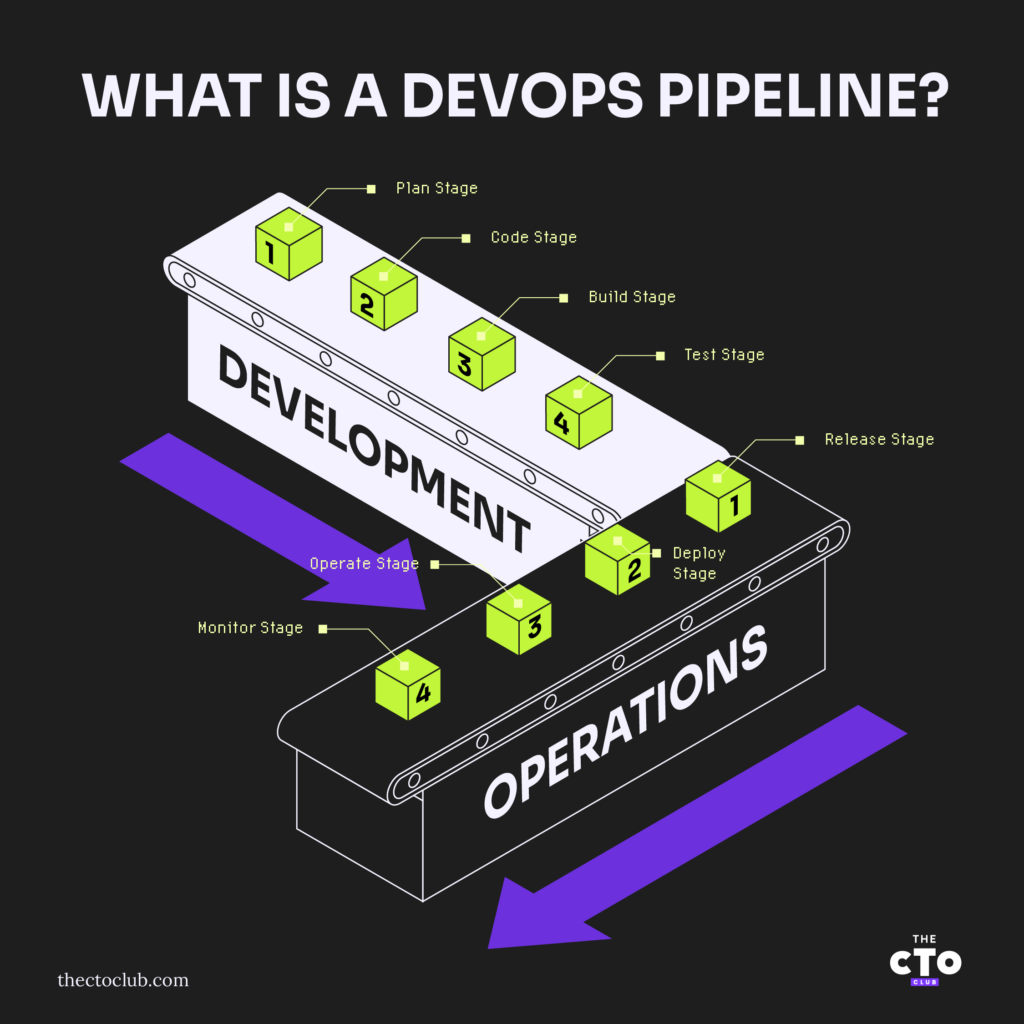Some things are better done slowly and manually. Others benefit from the magic of efficiency and automation. While coding is a skill that requires focus and meticulous attention to detail, it’s also a process that can be dramatically improved and expedited by building and implementing a DevOps pipeline.
A well-structured pipeline integrates automation, continuous integration, continuous delivery (CI/CD), and testing to ensure faster, more reliable releases with minimal errors.
In this guide, I’ll walk you through the steps to design and implement an effective DevOps pipeline that maximizes efficiency and supports your organization’s agile goals.
What is a DevOps Pipeline?
A DevOps pipeline is a bit like an assembly line. It’s a series of practices, processes, and DevOps tools used to build and deploy code from beginning to end. A DevOps pipeline can increase the speed at which you can build source code and deploy it, decreasing downtime and identifying errors that need to be corrected along the way.
The pipeline consists of two distinct aspects: Development (dev) and operations (op). Let’s take a look at the differences between the two:

Development
Development stages are when code is created and repaired. This includes activities like:
- Writing
- Testing
- Fixing problems
- Creating new features
- Updating existing code
- Patching
Operations
During the operations stages, the focus is deployment. This includes activities like:
- Releasing
- Deploying
- Operating
- Monitoring
The combination of these two aspects into an automated series of tasks is what creates a DevOps pipeline.
-

Site24x7
Visit WebsiteThis is an aggregated rating for this tool including ratings from Crozdesk users and ratings from other sites.4.6 -

Lumigo
Visit WebsiteThis is an aggregated rating for this tool including ratings from Crozdesk users and ratings from other sites.4.8 -

Nagios
Visit WebsiteThis is an aggregated rating for this tool including ratings from Crozdesk users and ratings from other sites.4.6
How Do You Build a DevOps Pipeline?
Having a pipeline in place will help your team to increase efficiency and mitigate the margin for error when creating and deploying code. If you’re interested in building a pipeline for your team, read about the five steps below and consider DevOps pricing options:
Pick Your CI/CD Tools
Continuous integration / continuous delivery (CI/CD) software will make your DevOps process easier and more efficient. There are several different tools available today, and each caters to slightly different needs.
Set Up a Control Environment
Any large project will require multiple coders working at once. With so many team members accessing and adjusting the same codebase, it’s easy to run into merge conflicts, redundancies, and communication errors.
Your control environment is a central place that stores all your code and makes it easy for coders to interact, reducing the risk of things like merge conflicts. Look for a tool that prioritizes communication and organization.
Some examples of source control management tools are:
- BitBucket
- Git
- GitLab
- Jenkins
- GitHub
- Docker
Design a Build Server/CI Server
Your build server or CI server helps you determine whether code works, and identify when it’s ready for production. Set up your server so that you have a centralized place from which to build development products.
Perform Tests
Now that you’ve set up your continuous integration server, you’ll need to test it. Make sure that your code is high quality and free of errors by running some of the following tests:
- Integration tests
- Automated unit tests
- Regression tests
- Functional tests
Deploy Product
Once you complete testing, you can move onto deployment. This can be done automatically or manually. Generally speaking, it’s best to first deploy manually because the slower pace will allow you to keep an eye on the code and identify any issues as they arise.
This process requires that you have a server infrastructure in place. The type of infrastructure you use will be dependent on the type of software you’re creating, and the tasks it will complete.
What Are the Stages of a DevOps Pipeline?
DevOps teams create their pipelines per their specific needs, and every DevOps engineer will have a slightly different method for building out their methodology and automated processes.
During the release phase of your DevOps pipeline, teams frequently face bottlenecks due to unclear procedures. Applying effective release management practices can remove these obstacles, promoting a seamless transition between pipeline stages.
Let’s take a look at how the stages break down between development and operations:
The Development Pipeline
Here, we begin with building the source code.
Plan Stage
Begin by understanding your end user and the purpose of the project. Which architecture, technology, and production environment best support you in delivering the goal product? Decide which types of tools you’ll need and choose providers that offer the specific functionality you require.
Code Stage
Here’s where the development team begins writing the code for the project. This can be time-consuming, so automation tools are key at this stage.
Build Stage
In the build stage, you’ll take the code and build it out so that it can be tested. It’s critical to build within a development environment so that testing and bug fixes can be performed in the next stage.
Test Stage
Automated testing will help you identify errors and ensure the product is running as you’d like it to. Sometimes, performance or UX/UI testing takes place here as well. Code changes can be made here to address concerns.
The Operations Pipeline
Once the code has been written and built, the operations process begins.
Release Stage
The operations team begins by confirming that the product is indeed ready. From there, they build it using a staged approach to check for bugs and vulnerabilities.
Deploy Stage
The product is then taken as-is and moved to the production environment so that end users can interact with the product.
Operate Stage
In this stage, processes are automated as the operations team configures and manages the product inside the production environment.
Monitor Stage
Now that the product is in end-users' hands, the operations team can continuously monitor how successfully the product delivers its intended outcome. How are users responding? How are they behaving when interacting with the product? Decide which metrics are most important so that you can keep an eye on them in the future.
Create Your DevOps Roadmap
Creating an effective DevOps workflow will streamline your production process and expedite the software development lifecycle. Adding the right DevOps tools into the mix will help you further automate tasks such as:
- Continuous testing
- Continuous integration/continuous delivery
- Continuous monitoring
- Continuous feedback
- Writing new code
- Project management
- Creating a source code repository
- Unit tests
- Version control
- Software delivery
Want More?
Building a DevOps pipeline is essential for streamlining software development and delivery. It enables teams to automate workflows, reduce manual errors, and ensure consistent, high-quality releases.
To get the most out of your DevOps pipeline, focus on continuous improvement. Regularly evaluate your tools, processes, and team communication to ensure everything runs smoothly and evolves with your organization’s needs.
Subscribe to our newsletter for more tips and strategies on optimizing your development workflows and staying ahead in the DevOps world.







